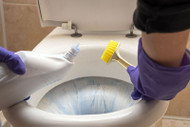How to Prevent RV Toilet Stains and Odors: Best Practices for a Fresh Bathroom
Posted by Happy Campers Store on Jul 15th 2025
How to Prevent RV Toilet Stains and Odors: Best Practices for a Fresh Bathroom
Keeping your RV toilet clean isn’t just about appearances—it’s about preventing odors, stains, and costly plumbing issues. Whether you're a weekend warrior or living in your RV full-time, developing the right habits is the key to keeping your bathroom fresh and your black tank system working efficiently. In this guide, we’ll cover the simple daily and weekly practices that prevent RV toilet smells and unsightly stains—plus what not to do if you want to avoid clogs and tank damage.
Why RV Toilets Require Special Care
Unlike residential toilets, RV toilets are connected to a black water holding tank that relies on gravity, water, and biological treatment to break down waste. They often feature a plastic or porcelain bowl with rubber seals and a manual or foot-pedal flush. These systems are more sensitive to buildup, clogs, and odors—especially in warm weather. Without proper care, waste can stick to the bowl or tank walls, bacteria can multiply, and odors can leak into your living space.
Want to better understand how your RV toilet connects to your plumbing system? Read our full guide: The Ultimate Guide to RV Plumbing Systems.
Common Causes of RV Toilet Stains and Odors
- Dry flushing: Not using enough water to flush solids can leave behind streaks and residue.
- Bacteria buildup: Without regular cleaning and treatment, bacteria thrive in warm, moist environments.
- Wrong cleaners: Harsh chemicals like bleach can damage seals and sensors while disrupting tank biology.
- Ventilation issues: Poor airflow can allow odors to build up in the bathroom.
- Improper tank habits: Leaving the black tank valve open can lead to dried waste buildup—commonly known as the dreaded “poop pyramid.”
Daily and Weekly RV Toilet Maintenance Tips
Simple habits go a long way in keeping your RV toilet fresh and stain-free. Here’s what we recommend:
- Flush with plenty of water: Always use enough water before and after flushing to carry waste to the black tank and rinse the bowl clean. This is especially important for solids.
- Wipe the bowl daily: Use a mild, RV-safe cleaner or a soft cloth with a vinegar solution to prevent ring buildup, discoloration, and bacteria growth.
- Deep clean once a week: Even with light daily cleaning, a weekly scrub using an RV-safe toilet bowl cleaner is essential. This helps remove unseen buildup and biofilms that lead to odors.
Need a walkthrough? Follow our Step-by-Step Guide to Cleaning Your RV Toilet.
Recommended Products That Protect Your Toilet
It’s important to use products that are safe for both your RV toilet and holding tank. Household cleaners can be too harsh and damage seals, corrode sensors, or interfere with the beneficial bacteria in your black tank treatment.
- RV-Safe Toilet Bowl Cleaners – Specifically formulated for plastic and porcelain bowls, and safe for septic and black tank systems.
- Happy Campers Organic Holding Tank Treatment – Breaks down waste and controls odors even in extreme temperatures, without formaldehyde or harmful chemicals.
Bad Habits That Make Stains and Odors Worse
Avoid these common mistakes that lead to persistent RV toilet problems:
- Dry flushing: Always add water before flushing solids. Without it, waste can stick to the bowl and lead to permanent stains.
- Leaving the black tank valve open when hooked up: This allows liquids to drain but solids to accumulate, creating blockages and intense odors.
- Using bleach or formaldehyde-based chemicals: These can break down seals, damage sensors, and kill the bacteria your tank treatment relies on.
- Using the wrong toilet paper: Non-RV-safe toilet paper can slow down waste breakdown and contribute to clogs and odor retention.
Still not sure if your TP is the culprit? Check out our full breakdown: Do You Really Need RV-Safe Toilet Paper?
Special Considerations for Hot Weather and Full-Time RV Living
If you RV in hot climates or full-time, your toilet system works harder to control bacteria and odors. Heat accelerates decomposition and evaporation, making preventative habits even more important.
Here’s how to stay ahead of problems:
- Use more water with each flush: The more you dilute waste, the less likely it is to stick and smell.
- Apply tank treatment consistently: In hot or humid conditions, odor control is non-negotiable. Use treatments like Happy Campers after every dump or at least weekly.
- Ventilate your bathroom: Use the exhaust fan after flushing and leave the door open when possible to reduce moisture and odor buildup.
- Rinse the black tank regularly: Even if it’s not full, a weekly flush helps prevent buildup. Here’s how to clean your RV toilet and tank safely without damaging seals.
What to Do If Stains or Smells Persist
Already following best practices but still getting toilet odors or bowl discoloration? Here are a few extra troubleshooting tips:
- Check the black tank vent pipe: Clogs or blockages here can force odors back into the RV. (Covered in our plumbing guide.)
- Inspect your seals: Cracked or dry seals can let odor escape. Apply a seal lubricant if needed.
- Sensor issues? If your tank sensors always read “full,” there may be buildup on the walls. Use a tank cleaning treatment or do a deep rinse with ice and water to dislodge residue.
Conclusion: Consistency Is the Secret to a Cleaner, Fresher RV Bathroom
RV toilet care doesn’t have to be complicated. By adopting daily cleaning habits, using the right products, and avoiding the most common mistakes, you’ll prevent stubborn stains and embarrassing odors before they start. Plus, your black tank system will last longer, sensors will function better, and your trips will be a whole lot more comfortable.
Need product recommendations? Don’t miss our comparison guide: The Best RV Toilet Bowl Cleaners That Are Safe for Your Septic System.


